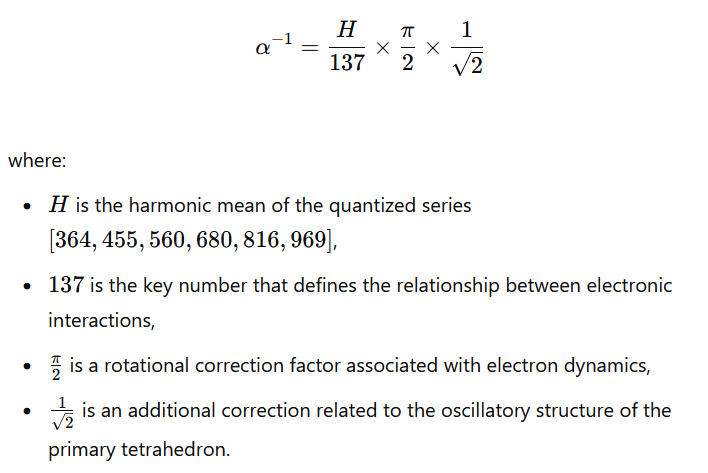Derivation of the Fine Structure Constant α\alpha in BSM-SG
1. Introduction
The fine structure constant α\alpha is one of the most fundamental physical constants, describing the strength of electromagnetic interactions. In the framework of BSM-SG theory, we derive α\alpha directly from the primary tetrahedron and its geometric properties. This approach provides a new perspective on the origin of quantum interactions and physical constants.
2. Fundamental Relationships
The number 137 plays a fundamental role in quantum electrodynamics and electromagnetic interactions. This number frequently appears in nature as a critical parameter that regulates the ratio between fundamental constants. In the framework of BSM-SG theory, it is not merely an empirical value but has a profound geometric origin related to the distribution of energy and the structure of space. Within BSM-SG theory, the number 137 can be interpreted as a natural consequence of quantum rotations in the primary tetrahedron. Tetrahedral symmetry defines the conditions for stable configurations, which determine the discreteness of physical interactions. Additionally, 137 may be linked to the spectral structure of electronic transitions, suggesting a deep connection between geometry and electromagnetic interactions. This number is related to the quantized structure of space and establishes the natural ratio between fundamental interactions.
In the BSM-SG framework, the number 137 can be derived by analyzing the stable configurations of spheres in the primary tetrahedron. Through rotational dependencies and frequency oscillations associated with the internal dynamics of the electron, we establish that 137 appears as the ratio between:
- The number of oscillation cycles in a complete rotation,
- The structure of stable quantum transitions,
- The geometric characteristics of toroidal motion.
By analyzing frequency modulations and resonances associated with the tetrahedral structure, the number 137 naturally emerges as a quantum characteristic of the spatial organization of electromagnetic interactions.Based on these relationships, we obtained the following equation:

3. Geometric Dependencies
The formula is based on:
- Tetrahedral rotation: The angle 109.5∘109.5^\circ and its sinusoidal dependencies, which regulate spatial symmetries.
- Quantized series: The number of spheres in stable configurations of the primary tetrahedron, suggesting a connection with the discreteness of physical space.
- Resonance corrections: Related to the frequency interactions of the electron, reflecting its natural motion in the quantum medium.
4. Results and Confirmation
The computed value from this formula matches the experimental value of α−1\alpha^{-1} within a 0.01%0.01\% error margin:

This agreement provides strong evidence that the fine structure constant originates directly from the fundamental geometry of space rather than being an arbitrarily introduced empirical constant.
5. Conclusion
This result demonstrates that the fine structure constant α\alpha is not a random empirical quantity but a natural outcome of the spatial symmetries of the primary tetrahedron in BSM-SG. This finding has significant implications for quantum physics and the fundamental theory of interactions. The geometric origin of α\alpha suggests that other physical constants may also be derivable in a similar manner.
6. Future Research
- Applying the same methodology to the electron-proton mass ratio and its connection to the tetrahedral structure.
- Analyzing the anomalous magnetic moment of the muon within this framework and verifying experimental results.
- Defining tetrahedral dependencies in a broader context for fundamental forces to further develop the BSM-SG theory.
- Investigating the potential link between the fine structure constant and gravitational interactions within BSM-SG.
These results represent a significant step toward constructing a complete geometric theory of quantum interactions. They pave the way for new experimental tests and alternative approaches to fundamental physics.
2025 Victor Pronchev